Described by Lawrence of Arabia as “vast and echoing”, Wadi Rum is a protected area covering 720 square kilometers of dramatic desert wilderness in the south of Jordan. The huge mountains of sandstone and granite are home to several Bedouin tribes and their goat hair tents are a feature of the landscape. We had the opportunity to explore Wadi Rum and stay overnight with theAl Zalabeyh Tribe who live exclusively in the Wadi Rum desert, and are the official caretakers of Wadi Rum.
Our day with the Bedouins began with a jeep tour of the highlights of Wadi Rum. We saw Lawrence’s Spring where Lawrence of Arabia reputedly washed during the Arab Revolt of 1916 – 1918. A Nabataean temple is at the base of the mountain and Nabataean inscriptions can be seen etched into the rock.
Our next stop was Khazali Canyon, a deep, narrow fissure in the mountain side containing many more Thamudic inscriptions on the canyon wall.
The large red sand dunes are quite fun to climb up. Barefoot is the way to go and the red sand is surprising cool!
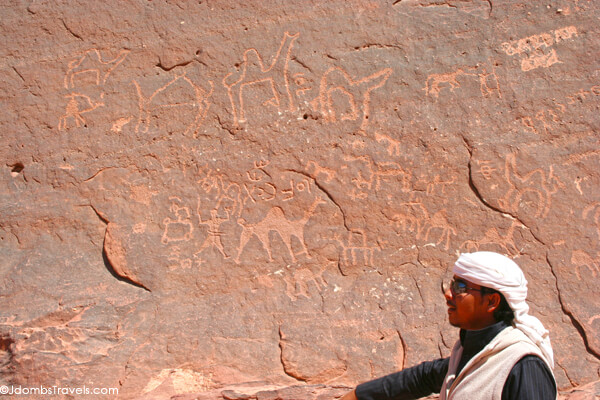
Nearing lunch time, we were dropped off to walk through the Burrah Canyon on our own. Mountains rose and both sides and I slipped off my shoes to feel the fine sand between my toes. After about an hour’s walk through the canyon, we finally spotted Ahmed waving us over for lunch. We sat down on the mat and were offered Bedouin tea. Bedouins have their own special blends of teas that they make from the dried leaves of various desert plants, most commonly sage as it is widely found in the area.Lunch was simple: pitas, tuna, and fresh vegetables. After lunch, relaxing and napping in the sun.
Then we were off again to see the Burdah natural rock arch, mushroom rock, and get dropped off again for another short walk through a beautiful canyon. A little scrambling over rocks was necessary and next more red sand dunes.
Our last stop before sunset was the Um Frouth rock bridge, where Ahmed effortlessly scaled the rock barefoot to the top.
Nearing sunset now, we were off to where Ahmed said was the best place to watch the sun sink below the mountains and observe all the changes in color of the surrounding rock. We sipped more Bedouin team and watched as the sunset turned the desert a stunning array of orange and red.
Finally we arrived at the camp for the night. One big, long tent is where everyone gathers around the campfire and eats. The low black tent is made from goat or camel hair that was woven by the women of the family. The tent is supported by a line of central poles in the middle, and the back and sides of the tent are supported by lower poles. In Bedouin culture the number of poles used in the back and side areas is a general an indication of wealth and social standing. Smaller, individual tents are where everyone sleeps.
We gathered around the hearth, situated in the main reception area of the Bedouin Tent and where all the tea, coffee, and food are served for guests. After being served more sweet tea, we learned about the Bedouin culture. Hospitality or diyafa is the highest Bedouin virtue. They are obliged to protect whoever enters their tent for three days. The Bedouin host is obliged to house, feed and attend to the needs of his guest for these three days, after which, the guest will be able to leave in peace.
We’re all called over to see dinner dug up! Zarb is the traditional Bedouin style of cooking using an in-ground, sealed charcoal-fired pit and then covered by the sand. The Bedouin chef prepares ample platters of chicken and whole root vegetables that are then lowered into the ground for a duration of up to 3 hours. After the hours of slow cooking, the steaming Zarb is removed from the pit to reveal a meal punctuated by the tantalizing aroma of herbs and spices. The Zarb is both prepared and consumed the traditional way – communally.
After dinner we learn more about the Bedouin culture and the importance of the camel. A good camel costs around 5000 Jordanian Dinar and most of the camels come from Saudi Arabia. The camels are able to roam free through the desert and it is not uncommon for them to wander off for 2 or 3 weeks. The camels always return to the place they know they get food and water, so wandering off is not a concern.
We also learned about the coffee ceremony when welcoming a guest. It is customary to have three small cups of tea or coffee before the host will sit down and discuss affairs with their guest. The host will not generally ask about their troubles, but will discuss matters concerning animals, and news from afar.A guest who asks for a fourth cup is considered to be greedy or wanting something.
After a few more stories, we wandered around the camp to look at the star filled sky and the nearly full moon. Finally ready for bed, we made our way to our tent. Even though the night was chilly, the goat hair blankets kept us warm.
We awoke to the smells of breakfast bright and early as the Bedouins are early risers. Taking our places onthe communal mat, we were once again served sweet tea, coffee, and an ample breakfast. Our camels awaiting us to take us on a two hour trek back to the Village, we waved goodbye to our new Bedouin friends and climbed aboard our camels.
We had a wonderful experience staying with and learning about the Bedouins.
Know Before You Go
- Bring towelettes to clean up with.
- The camp does have a shower and wash closet, but not hot water.
- Wear pants without seams for camel trekking. Just trust us on this one!
This is a UNESCO World Heritage Site. For more info click here.
You can see all the UNESCO World Heritage Sites we’ve visited here.

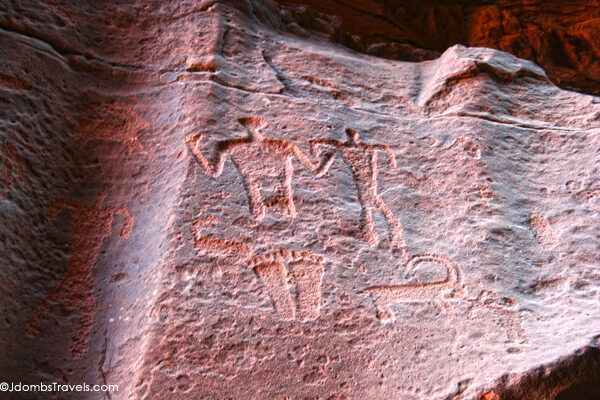
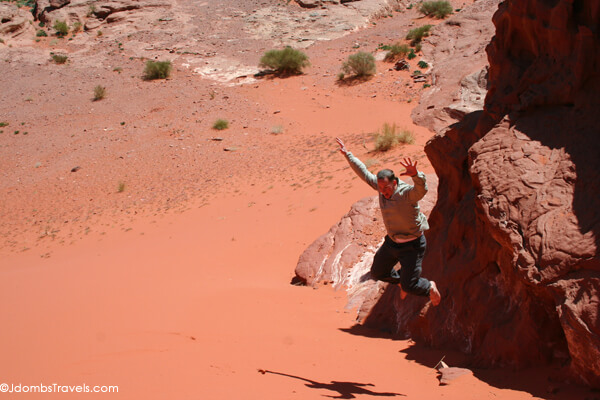
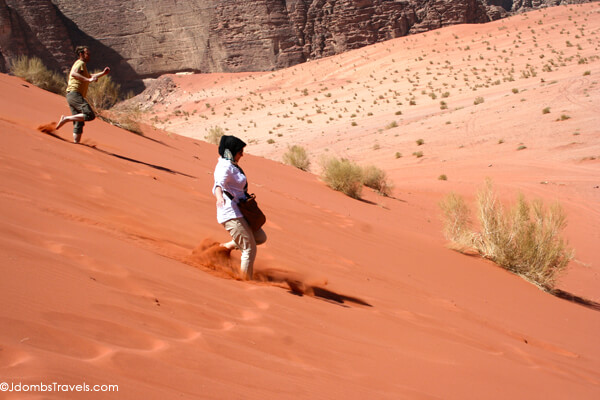
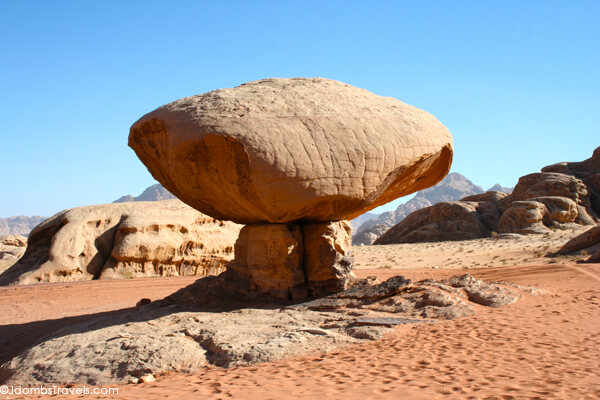
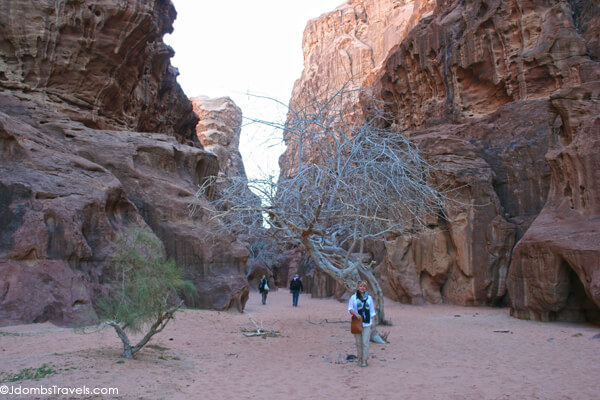
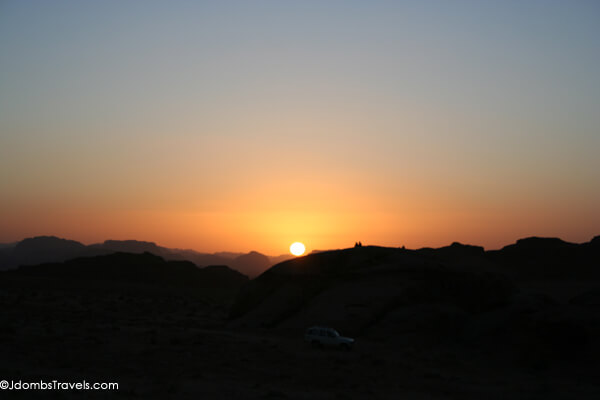

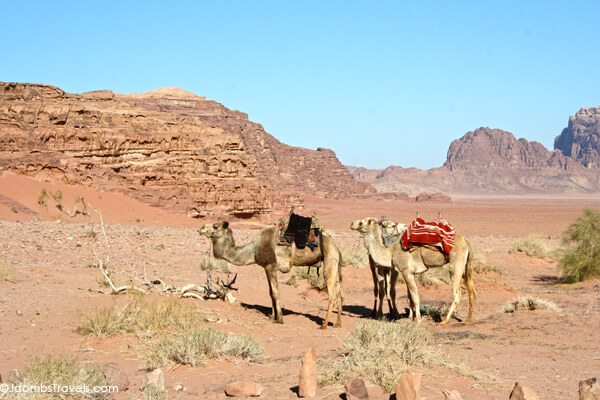


Celma says
I have never heard anything like this before, it is beautiful. Best of luck with your posts.
The Drifters Blog says
Yes, this was definitely something that I've always wanted to do!
Jennifer says
We highly recommend it, The Drifters Blog! This was one of our favorite adventures in Jordan.
cosmo Hallitan says
Wow, what an amazing adventure! This is going on my Jordan bucket list!
Jennifer Dombrowski says
It really is such a great experience, Cosmo! The Bedouins tell fantastic campfire stories. 🙂
Elle-Rose Williams says
I love this part of the world so much – those colours in the sand are just breathtaking. x
Jennifer Dombrowski says
We did too! Our trip to Jordan was very last minute and we literally knew nothing about the country except that we wanted to go to Petra. It took us by surprise and we loved every minute of our visit.
Jonny Blair says
I just did a tour of the Wadi Rum deserts and loved it! Safe travels. Jonny
Rachel says
Ahhhh! I visited Wadi Rum back in 2010 and stayed with the wonderful Obeid, and had the most fantastic Bedouin experience. We had sand baked chicken, hiked to the top of a rock to watch the sun go down and spent so long on camels, my backside bloomin’ hurt. It was superb.
Jennifer Dombrowski says
LOL Rachel! We weren’t a fan of the long camel ride either. But we’d head back to Jordan in a heartbeat. Loved it there!
Sonia says
We loved our day in Wadi Rum. I wish we could have seen the Milky Way as well!
The Photography Confidential says
I looks amazing!
Amalia says
Hello,
Hope you are well.
We would like to do a trip to Jordan with one day spent in the Holy Lands Israel to see the basic sites.
Can you please provide us with the options for this trips and costs.
Ideally, we would like to spend 2 days in Wadi rum and our camp of choice is Rum stars.
We would like one day in Petra and maybe possibly 2 days in Aqaba or red sea.
, we are based in London.
Thank you,
Amalia
Jennifer Dombrowski says
Hi Amalia,
You’ll love Jordan!
We’re not a travel agency. We’re an online travel magazine and you can find all of the information of which companies we used ourselves and recommend on our site. We simply rented a car during our 10-day long trip and visited the Holy Lands of Madaba, Bethany-Beyond-the-Jordan and Mount Nebo ourselves. We also visited Petra independently.
You can contact Rum Stars for their price for the 2-day Wadi Rum tour.
Amalia says
Thank you for your help!